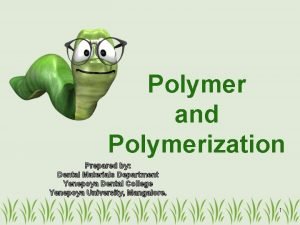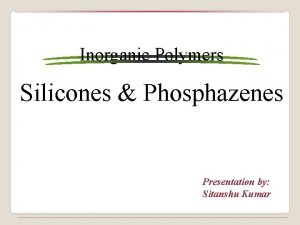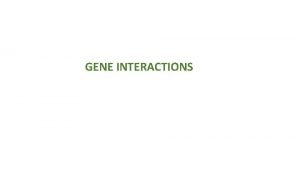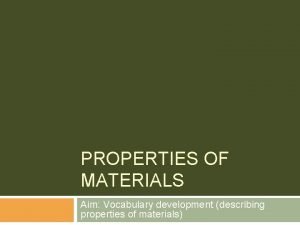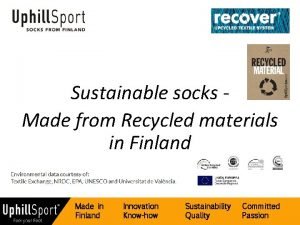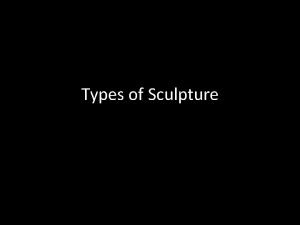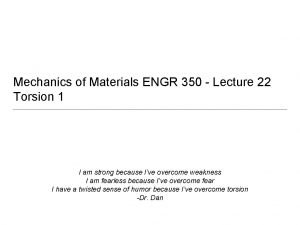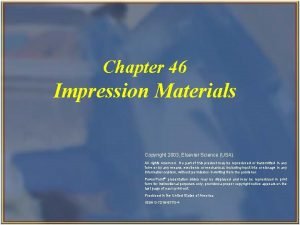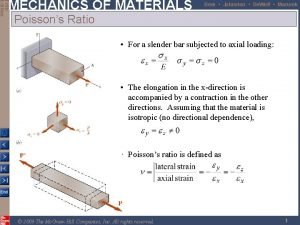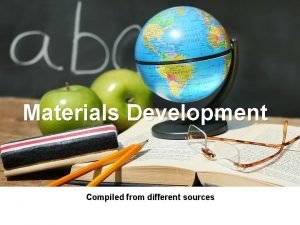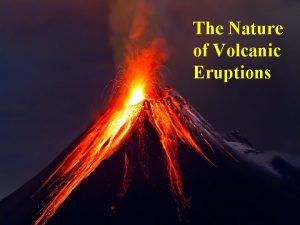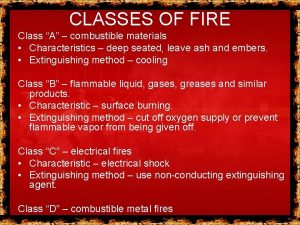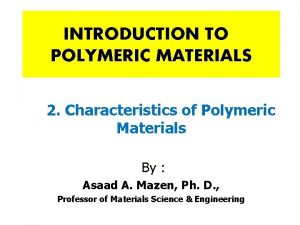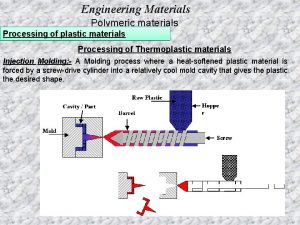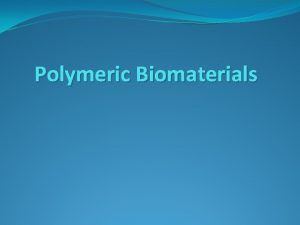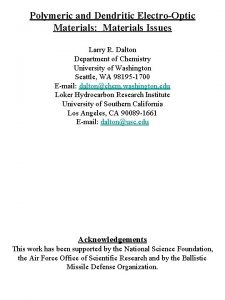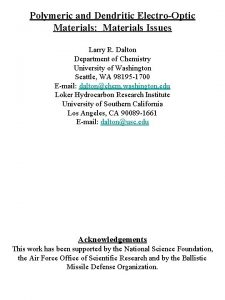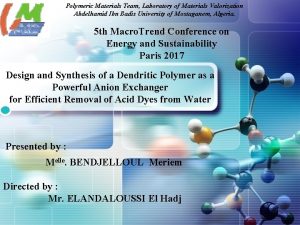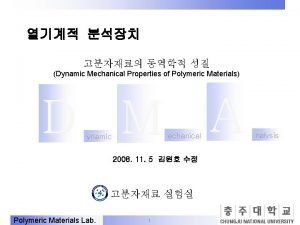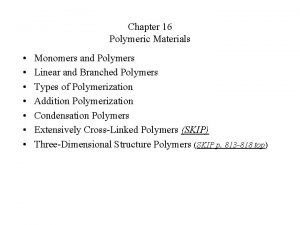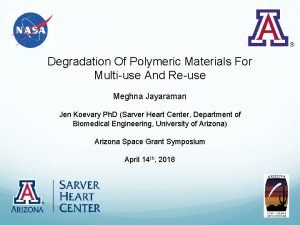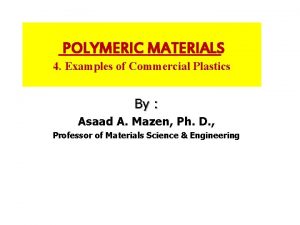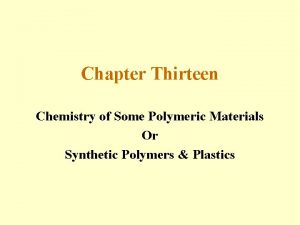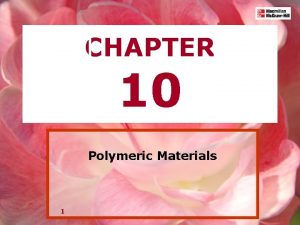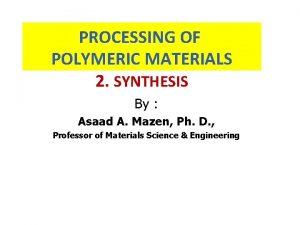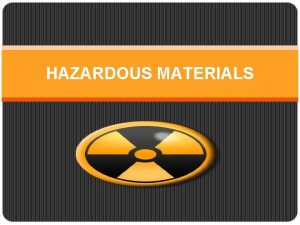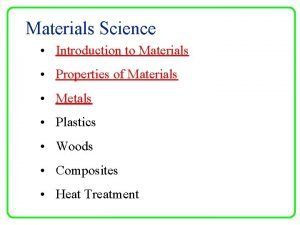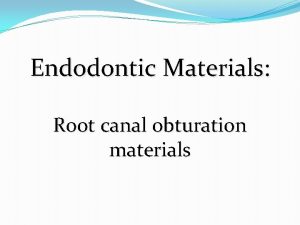Polymeric Materials Part I 11252020 1 What is







































- Slides: 39

Polymeric Materials - Part I 11/25/2020 1

What is a Polymeric Biomaterial? 11/25/2020 2

What is a polymer? l l l The word is from Greek roots “poly” meaning many and “meros” meaning parts. Many scientists prefer the word “macromolecule”. If one discounts the end uses, the differences between all polymers, whether natural or synthetic, are determined by the intermolecular and intramolecular forces that exist between the molecules within the individual molecules and by the functional groups they contain. 11/25/2020 3

Polymers l l If we disregard metals and inorganic compounds, we observe that practically everything else in the world is polymeric. This includes the protein, nucleic acid and sugars that make up all cells and their extracellular matrix, the fibers in our clothing, the food that we eat, the elastomers in our tires, the paint, plastic wall and floor coverings, our foam insulation, dishes, furniture of our homes, etc. 11/25/2020 4

How are they used? 11/25/2020 5

Polymeric Biomaterials are used in a Broad Range of Products 11/25/2020 6

MEDICAL PLASTIC MARKET FORECAST TO CROSS 2. 6 BILLION POUNDS BY 2004 Worldwide l l Plastic usage in the healthcare field encompasses several distinct markets-including disposable or single use biomaterials. Predominant are applications for medical devices and related products and packaging. 11/25/2020 7

Medical Plastics Market l l l Non-disposables comprise slightly over 50% of total volume. Commodity thermoplastics currently dominate the market with a little under 50% of total volume, having a consumption level of 956 million pounds in 1999. Almost 80% of polymers used in the medical industry are represented by PVC, polypropylene and polystyrene. 11/25/2020 8

Medical Plastics Market l l Major nondisposable markets include testing/diagnostic equipment, surgical instruments and related equipment, prostheses/implants, dental/ophthalmic devices; Disposable products include syringes, kits, labware, tubing, blood bags, utensils, gloves, trays, catheters, thermometers, etc. 11/25/2020 9

Polymer Science and Processing Technology Successful product design requires a knowledge of: l the requirements of the final product; l the behavior of polymeric materials; l commercial polymer processing technology; and l relevant cost and market factors. 11/25/2020 10

Polymer Science and Processing Technology l l At the heart of polymer science and technology is molecular structure. It dictates not only final product properties, but the type of polymer synthesis and the potential processing methods. 11/25/2020 11

Learning Resource The Macrogalleria www. psrc. usm. edu/macrog/index. htm Read through levels 2 -5 11/25/2020 12

Molecular Arrangement of Polymers l l Most polymers are large linear macro-molecules. This chain is called the backbone. Normally, some of these atoms in the chain will have small chains of atoms attached to them. These small chains are called pendant groups. Pendant chains normally have just a few atoms, but the backbone chain usually has hundreds of thousands of atoms. 11/25/2020 13

The Structure of Polymers l Below is a diagram of polyethylene, the simplest polymer structure l There are polymers that contain only carbon and hydrogen. These are referred to as hydrocarbons-exs. Polypropylene, polybutylene, polystyrene, and polymethylpentene l 11/25/2020 14

Polymers have a Repeating Structure l l We like to think that the atoms that make up the backbone of a polymer chain come in a regular order, and this order repeats itself all along the length of the polymer chain. For example, in polypropylene, the backbone chain is made up of just two carbon atoms repeated over and over again. 11/25/2020 15

Material Science Logic Performance/Application Structure Synthesis +processing 11/25/2020 Properties • Physical • Biological 16

Basics of Polymer Structure l What distinguishes polymers from other organic compounds is molecular weight and dimension? 11/25/2020 17

The Structure of Polymers l l l Even though the basic makeup of many polymers is carbon and hydrogen, other elements can also be involved. Oxygen, chorine, fluorine, nitrogen, silicon, phosphorous, and sulfur are other elements found in the molecular makeup of polymers. Polyvinyl chloride (PVC) contains chlorine. Nylon contains nitrogen. Teflon contains fluorine. Polyester and polycarbonates contain oxygen. 11/25/2020 18

The Structure of Polymers l l l There also some polymers that, instead of having a carbon backbone, have a silicon or phosphorous backbone. These are considered inorganic polymers. Polysiloxanes (Silicones) and Polyphosphazenes 11/25/2020 19

Vinyl Polymers l l l Vinyl polymers are polymers made from vinyl monomers; that is, small molecules containing carbon-carbon double bonds. They make up largest family of polymers. Let's see how we get from a vinyl monomer to a vinyl polymer using for an example the simplest vinyl polymer, polyethylene. 11/25/2020 20

Polyethylene 11/25/2020 21

Vinyl Polymers polypropylene polyvinylchloride 11/25/2020 polystyrene polymethylmethacrylate 22

PTFE polytetraflouroethylene 11/25/2020 23

Other Carbon Chain Polymers Homopolymer l If X=H then polyethylene l If X = CH 3 then polypropylene l If X = Cl then polyvinylchloride l If X = Benzene ring then polystyrene 11/25/2020 H H -C–CH X n 24

Chemical Structure of Some Common Polymers Poly(methylmethacrylate) “PMMA” Poly(acrylate) “PAA” 11/25/2020 Poly(vinylacetate) “PAVc” Poly(vinylchloride) “PVC” 25

Chemical Structure of Some Common Polymers Poly(vinylidene chloride)“PAVc” Poly(hexamethylene adipamide) 11/25/2020 “Nylon 6, 6” Poly(ethylene oxide)“PEO” Poly(caprolactam) “Nylon” 26

Chemical Structure of Some Common Polymers Poly(ethylene terephthalate)“PET” Poly(dimethyl siloxane) 11/25/2020 Poly(carbonate) Poly(methyl styrene) 27

Classification- Chain Architecture: Linear Structures l Many thermoplastic polymers are built so their molecules consist of many thousands of atoms arranged into long linear chains. But they don't have to be long straight chains. 11/25/2020 28

Polymer Structure l Also we know that each such carbon to carbon bond allows full rotation in both molecules, so that in reality the chains are seldom extended to their full contour length but are present in many different shapes, or conformations. 11/25/2020 29

Illustration of the random coil model. One chain is marked boldly. 11/25/2020 30

Consequences of the random coil model l Crystallization strongly impeded by chain entanglement-only partial crystallization or glassy state upon cooling of a melt Entanglement gives rise to very high viscosity of polymer melts Entropic restoring force upon stretching of a chain- entropy elasticity of elastomers 11/25/2020 31

Branched Polymers l l l Not all polymers are linear in this way. Sometimes there are chains attached to the backbone chain which are comparable in length to that backbone chain. Some thermoplastic polymers, like polyethylene, can be made in linear or branched versions. This gives them a 2 -D quality. 11/25/2020 32

HDPE vs LDPE HDPE LDPE The branching increases the volume and thus reduces the density of the polymer. 11/25/2020 33

Other Linear Polymers l l Proteins are linear polymers that consist of all levo-isomers of amino acids. In contrast, the building blocks of starch and cellulose are d-glucose and are joined by both condensation through both alpha and beta acetal groups. 11/25/2020 34

Star Polymers l l l Sometimes the ends of several polymer chains are joined together at a common center. Polymers like this are called star polymers. They're often used as additives or as coating materials. 11/25/2020 35

Dendrimer l l l Sometimes there is no backbone chain at all. Sometimes a polymer is built in such a way that branches just keep growing out of branches and more branches grow out of those branches. These are called dendrimers, from the ancient Greek word for "tree". 11/25/2020 36

Cross-linked Polymers l l l Sometimes, both ends of the branch chains are attached to the backbone chains of separate polymer molecules. If enough branch chains are attached to two polymer molecules, it can happen that all of the polymer backbone chains in a sample will be attached to each other in a giant 3 -D network. This is what happens in certain hydrogels, polyelectrolytes, rubber, silicone and certain polyurethanes. 11/25/2020 37

Types of Polymers l l l l Thermosets Classification based on Processing Thermoplastics Elastomers – Classification based on mechanical properties Hydrogels- Classification based on chemical properties Polyelectrolytes-Classification based on chemical properties Natural-Classification based on origin Biodegradable-Classification based on biostability 11/25/2020 38

Learning Resources www. msm, cam. ac. uk/ University of Cambridge Department of Materials Science and Metallurgy Teaching: Do. ITPo. MS Project Library of Teaching and Learning Packages for Materials Science www. msm. cam. ac. uk/doitpoms/tlplib/index. php THE GLASS TRANSITION IN POLYMERS (required reading) 11/25/2020 39
 Dental monomer and polymer
Dental monomer and polymer Polymeric backbone of silicones and phosphazenes
Polymeric backbone of silicones and phosphazenes Transversion
Transversion Favourite cars
Favourite cars Direct materials budget with multiple materials
Direct materials budget with multiple materials When a material useful
When a material useful Natural materials and man made materials
Natural materials and man made materials Adapting and adopting materials
Adapting and adopting materials Part part whole
Part part whole 미니탭 gage r&r 해석
미니탭 gage r&r 해석 Technical description meaning
Technical description meaning Addition symbol
Addition symbol 3 parts of the bar
3 parts of the bar Part to part ratio definition
Part to part ratio definition The phase of the moon you see depends on ______.
The phase of the moon you see depends on ______. Optical properties of engineering materials
Optical properties of engineering materials Disadvantages of master budget
Disadvantages of master budget Open materials badge
Open materials badge Things made of different materials
Things made of different materials Properties of materials vocabulary
Properties of materials vocabulary Polishing cake uses in dentistry
Polishing cake uses in dentistry Recycled material socks
Recycled material socks The cross legged captive
The cross legged captive George segal paintings
George segal paintings Institute of supply and materials management
Institute of supply and materials management Torsion mechanics
Torsion mechanics Copyright
Copyright Difference between musharakah and mudarabah
Difference between musharakah and mudarabah Ndsu bookstore course materials
Ndsu bookstore course materials Taisil
Taisil 5 properties of materials
5 properties of materials Material technology positive and negative impacts
Material technology positive and negative impacts Beer
Beer Development of teaching learning materials
Development of teaching learning materials Location cost volume analysis
Location cost volume analysis Bernard gelduin
Bernard gelduin Paricutin materials extruded
Paricutin materials extruded Advanced materials
Advanced materials Class a combustible materials are
Class a combustible materials are Uninstalled materials asc 606
Uninstalled materials asc 606
